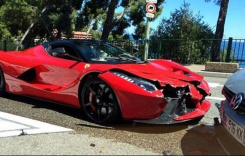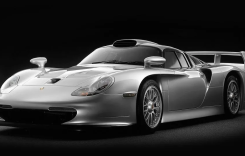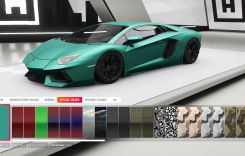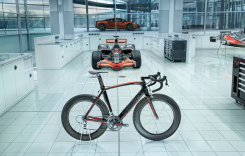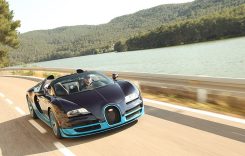When the first Polaris-produced Indian Motorcycles were introduced on Main Street at the 2013 Sturgis Rally, the Chieftain was the biggest surprise of the bunch and elicited the loudest ovation from the crowd. A motorcycle with a fork-mounted fairing and hard saddlebags was a first for the company. It gave them a strong competitor in a very lucrative niche, both in the production and aftermarket sectors. The Chieftain matched up with the hugely popular bagger of Indian’s primary American competitor, the Harley-Davidson Street Glide. And the bagger segment has been riding a wave of popularity in recent years, spawning TV shows like “Biker Battleground Phoenix.” Go to just about any custom bike show and the bagger competition is always the most hotly contested.
Of course, simply launching a bike into a new niche doesn’t mean crap if the proper amount of time hasn’t gone into its design and engineering. Fortunately, Indian did its homework and produced a bike that strikes an emotional chord aesthetically and also performs at competitive levels with other top-tier baggers.
Though baggers are identified by signature cues, Indian did an admirable job of providing the Chieftain with its own identity by combining heritage and modern traits. Valanced fenders, the headdress logo on the tank, and the War Bonnet emblem on the front fender pay tribute to its predecessors. The Chieftain’s thunderous V-Twin does likewise as the design of its fins and parallel pushrod tubes were borrowed from Chiefs of the early 1940s.

The Chieftain’s front fairing sports its own unique design, classy like a Cadillac, from the chrome wings around its headlight to the tidy integration of the turn signals. The motorcycle’s 1811cc engine is packaged tightly within a cast aluminum chassis, a first for the company. Using cast and forged aluminum keeps the frame’s weight down to a claimed 58 pounds. The aluminum design also houses the airbox in the frame’s backbone, which helps force-feed the monster powerplant. The motorcycle is equipped with a bevy of electronic conveniences, including a windscreen that raises and lowers at the push of a button, cruise control, saddlebags that lock remotely, keyless ignition and ABS. Yes, Indian has done a bang-up job of finding the happy median between old and new.
To sample the merits of the 2016 Chieftain, we hopped onboard Indian’s bagger in Austin, Texas, and set our sights on Fayetteville, Arkansas. We were headed to the Bikes, Blues & BBQ rally and what better way to give the Chieftain a proper shakedown than head out on a six-day, 1600-mile road trip through three states and over the Ozarks. This particular 2016 Indian Chieftain was outfitted with some useful aftermarket additions, including a KlockWerks Flare Windshield, wide solo seat and luggage rack, with the last two straight out of Indian’s P&A catalog. It also sported the new Silver Smoke colorway, and while we know Indian’s trademark is red, the silver makes for one devilishly handsome Chieftain.
Packing for the road, the luggage rack accessory immediately paid dividends. We crammed the saddlebags full, from clothes to cameras to a 17-inch laptop, each bag providing 17.2 gallons of storage space. But we still had our backpack left-over, which we didn’t want to sling over our back, so we bungeed it down on the rack. The KlockWerks Flare Windshield also proved its worth. In the down position, my head was buffeted by quite a bit at freeway speed, but raising it fully sent air flow up and over the crown of my helmet. However, in this position there was some whistling at speed coming from underneath.

On the road, the Thunder Stroke 111 of the Chieftain delivers an immediate bounty of torque. The clutch lever is tight and springy, but the Chieftain uses throttle-by-wire, with the system dialed in nicely so it quickly responds to every twist. Last year we threw the Chieftain on our dyno where it registered a verifiable 102.15 lb-ft at 3000 rpm and 74.40 hp at 4600 rpm. It reaches the 100 lb-ft plateau as low as 2300 rpm and gives riders the capacity to run it low in the range without downshifting because it has no problems picking back up. It stays in that 100 lb-ft range up to 3200 rpm and the same engine the current Chieftain runs put up a respectable 0-60 mph time of 5.3 seconds on the street in the hands of our Road Test Editor Adam Waheed. First gear propels the big bagger up to about 43 mph before redlining at approximately 5600 rpm, second gear winding out at near 63 mph at a bit lower 5500 rpm. Need to get up to freeway speed? The big V-Twin has no problems. Once there, shift it up a few gears and it settles into a healthy low rev cadence without rattling your teeth out and has solid mid at the ready when it comes time to scoot past traffic. Many Texas highways sport 75 mph speed limits and the Indian Chieftain will cruise comfortably at 80 mph all day long, doing so for us at an efficient 38.42 mpg.
A testament to its credentials as a road tripper is the fact that after a 600-mile day in the saddle I still felt relatively fresh and easily could have ridden more miles. The front fairing not only looks slick, it shields riders well. The solo seat from the Indian accessories catalog is shaped sound and supports riders with few pressure points. The floorboards are long so you can shift your feet around on those occasions when fatigue does settle in and the riding position is open and relaxed for a six-foot-tall rider. The suspension set-up also makes long stints in the saddle that much easier. Though it runs a single shock on the rear, the ride is smooth and rebound is pert-near ideal. The pneumatic rear is preload adjustable but requires a hand pump and the removal of the left side cover below the seat to access the air fitting above the fuse box. The front has an ample 4.7 inches of travel but rebounds quickly and the front can feel a tad bouncy on rough roads.
The majority of the time it’s a non-issue, but at times hustling through some of the tighter bends the Chieftain required constant input at the handlebars to keep it on the desired line. And there was no shortage of twisties in the Ozarks to test it on. While nearing the Oklahoma/Arkansas border, a local rider tipped us off about “the best motorcycling road in the state” and when the sign at its turnoff said “Winding Stair” you knew you were in for a treat. The road climbed up a series of bends to the ridgeline as Highway 1 cut through Ouachita National Forest. The low-end torque of the Indian Chieftain powered the big bagger up the grades effortlessly and the next 50 miles was spent predominantly in second gear as we went on a roller coaster ride up and down the ridgeline, countless viewpoints on both sides of the road offering panoramic vistas as far as the eye could see. The 2016 Chieftain has a tighter rake than the other big Indians at 25-degrees and the shortest wheelbase at 65.7-inches and has a maneuverability that belies its size. Little effort is required to initiate a turn because the front fairing doesn’t inhibit steering despite being fork-mounted and cornering clearance is fairly ample. With a little pressure on the rear brake and just the right amount of friction on the clutch, the big bike is manageable at low speeds. Its center of gravity sits low thanks in part to a laden 26-inch seat height. Add in the fact that the seat is fairly slim where it meets the tank and planting two-feet firmly on the ground is a fuss-free affair.
Back on the freeway and banging through gears, the transmission is a little rough around the edges, particularly in the first couple of gears where engagement is hard and deliberate. The transition is smoother in the middle gears though. When it’s time to haul in the beast, you’ve got to put a tight squeeze on the right lever to really get into the 300mm dual floating rotors of the front as initially they’re a tad squishy. The single 300mm disc on the rear with its 2-piston caliper demonstrated a stronger initial bite. The 2016 Indian Chieftain does have the benefit of standard ABS that isn’t overly touchy, and when we tested the package last year against the Street Glide, the Indian broke it down from 60-0 mph quicker, requiring 122.2 feet compared to the Harley’s 133.2 feet.
And while the ABS on the Chieftain gets our stamp of approval, it has a list of standard features that made our miles in its saddle that much more enjoyable as well. The cruise control buttons on the right control housing are easy to engage. Simply get up to speed, press the Set/Dec button, and enjoy the ride. If you feel the need for a bit more speed, press the Res/Acc portion of the button and it will bump up speed one mile-per-hour at a time. The left housing is used for controlling the audio and auxiliary systems, from an iPod to smartphone, and I could operate most of the controls without releasing my grip on the handlebars, the one for the electronically adjustable windscreen in the far right-hand corner the primary exception. A small cubby hole in the right side of the fairing houses a cable to connect your electronics, but to run Bluetooth you’ll need a driver headset. At a setting of 13-14, audio pumped out of the 100-watt, two-speaker system loud and clear. The instrument cluster inside the fairing includes a small digital display centrally located that provides everything from diagnostic information to audio settings, the digital display sandwiched between the analog dials of the speedo and tach. Thanks to an orange backlit display, the dials are highly visible night and day. Speaking of night riding, the Chieftain’s headlight puts out a healthy punch. If we wanted to increase spread it has fog lights, too, activated with a quick push of a button in the upper right corner of the inner fairing.
In the case of the 2016 Indian Chieftain, a standard ignition is replaced by a key fob that must be in proximity to the bike to activate the push-button starter. It also electronically locks the saddlebags and activates the security system. The problem is one time we had a sync issue between the bike’s ECM and the fob and the motorcycle wouldn’t start. The ECM recognized that the fob was in proximity and initially the electronics would come on, but then for some reason it determined the code was askew and wouldn’t allow the bike to turn over and shut off automatically after 20 seconds as a security measure. You can manually override the system with a four digit personal password using the left turn signal, but we didn’t have that code so were stranded until we got an Indian tech to come over the next day and re-sync the fob. (Luckily Indian was doing demo rides at the Bikes, Blues &BBQ Rally and their rig was only about a half-mile from our hotel). This is the second time we’ve had an issue with Indian’s fob as one time we couldn’t get the Indian Roadmaster we tested to turn over as well.
In addition to the fob foibles, on the second day of riding, we noticed a small pool of oil below the transmission. Without tools at our disposal we couldn’t pinpoint the leak, but once the Indian techs were able to look at it we learned the oil filter hadn’t been tightened down properly and airflow was pulling oil up into the crankcase causing it to seep, a rushed maintenance job being the chief culprit. This was the exception not the norm, though, as we’ve ridden all three years of the Indian Chieftain and spent several months on the Roadmaster and none of them leaked at all.
After 1624 miles in its saddle, the 2016 Indian Chieftain proved its worth as a road warrior. Powerful, comfortable, with rear suspension that’s dialed-in properly and plenty of creature rider comforts like an electronically adjustable windscreen, cruise control and ABS, we could see ourselves easily going iron butt on this motorcycle. We’d do so in style thanks to the bike’s distinctive lines and striking design. It’s only a few tweaks away on the front end from being a really good handling motorcycle, and we’re still not fans of its fob, but we wouldn’t hesitate to pack up its bags and chart a cross-country course to Sturgis any given day.

